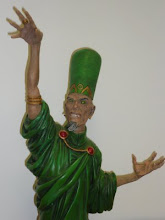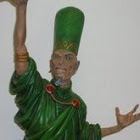 A hugely enjoyable and engaging comic that takes a genre staple to very happily unexpected directions with style and force. There is a vampire settlement in werewolf country, the settlement is an expression of religious devotion to the dictates of the vampire god. The werewolves consider the settlement to be sacrilege, the battle between the settlement and the wolves is total, there can be no peace only victory. As the leader of the settlement is recalled to the vampire city he finds that the brutal simplicity of the settlement leaves him dangerously unprepared for the politics of the Kingdom. The settlement has a troop of soldiers from the city arrive and they bring the same conflict with them. There is also the severe problem of the vampire, a (unintentional) hero to the vampires, who arrives at the settlement and does not return from a trip further into wolf country. An apparently straightforward conflict is becoming complex and the settlement will have to work hard to identify their real enemies.
A hugely enjoyable and engaging comic that takes a genre staple to very happily unexpected directions with style and force. There is a vampire settlement in werewolf country, the settlement is an expression of religious devotion to the dictates of the vampire god. The werewolves consider the settlement to be sacrilege, the battle between the settlement and the wolves is total, there can be no peace only victory. As the leader of the settlement is recalled to the vampire city he finds that the brutal simplicity of the settlement leaves him dangerously unprepared for the politics of the Kingdom. The settlement has a troop of soldiers from the city arrive and they bring the same conflict with them. There is also the severe problem of the vampire, a (unintentional) hero to the vampires, who arrives at the settlement and does not return from a trip further into wolf country. An apparently straightforward conflict is becoming complex and the settlement will have to work hard to identify their real enemies.Werewolves fighting vampires is an gene staple for a really good reason, it holds a huge range of story possibilities, Jim Alexander strikes out in a wonderfully unexpected direction with two really smart decisions, the first is to exclude humans from the story and the second was to frame the conflict as a religious war. Without humans the vampires and werewolves have to stand on their own as two self sustaining societies locked in a conflict that cannot be undone. This gives the story a force and focus that it needs it means that werewolves and vampires are not marginal predators in a human society but the mainstream actors in their own. They get to have a entirely serious conflict with possibilities and complex implications which allows them emerge as really engaging characters involved in a weight and consequential circumstances. Jim Alexander takes full advantage of the story possibilities arising from having outsiders arrive in the settlement and the leader of the settlement be an outsider in the Kingdom to explore the details of vampire society. The details arise naturally from the action of the story and the reveals are sharply set up to explore the divisions as well as reveal assumptions and the structures of the society. A really well developed picture of a society emerges as well as the pressures exerted by the conflict, the multiple dimensions are made clear without ever dropping the tension or slowing the momentum of the story.
Luke Cooper is the artist for the first issue in the volume, Will Pickering is the artist for the other issues. The art transition is noticeable and not distracting, both artists capture the story with force and subtlety. The story makes very severe demands on the art, it has scenes of tremendous action and also very quiet scenes which contain critical information that cannot be simply info dumps for the reader. Luke Cooper places the settlement in an identifiable context, the fort in the hostile American cinematic west, the settlers capture the looks and manner of the settlers in Indian country. This gives the reader an instant footing in the story and allows the fact that it is not Cowboys and Indians but werewolves and vampires to simply not distract from the story. The story gets started right away without any unnecessary distraction about having to explain why werewolves and vampires. Will Pickering takes the story to the big city with Halfpenny, the settlement leader being summoned there. The city context is clearly contemporary, the contrast with the settlement is made clear with every detail.
The cast are drawn by Luke Cooper and Will Pickering with such natural movements and expressive faces and body language that they bring forth all of the implications and nuances of the script without effort. Reading the comic is such a pleasure because so much of the possibilities of a comic are being utilised with such skill, the story is being told by the words and art in such a balance that it is easy to miss just how much of a story is being told.
Jim Campbell's lettering is so unobtrusive as to be nearly invisible, it reads wholly as part of the actions of the cast in the panel and never pulls the reader from the story. His sound effects on the other hand are exactly as eye catching as they should bee and capture the moments with welcome humour. Wolf Country is a big deeply satisfying read, there is a huge story unfolding in a very engaging way that arises directly from its premise, all delivered by an astonishingly creative team.
Chief Wizard Note: This is a review copy very kindly sent by Jim Alexander. To purchase a copy of Wolf Country Volume 1, which you should do it will provide elevated levels of joy and happiness with the side effect of a greater pleasure in living, you can do so here https://www.etsy.com/uk/




